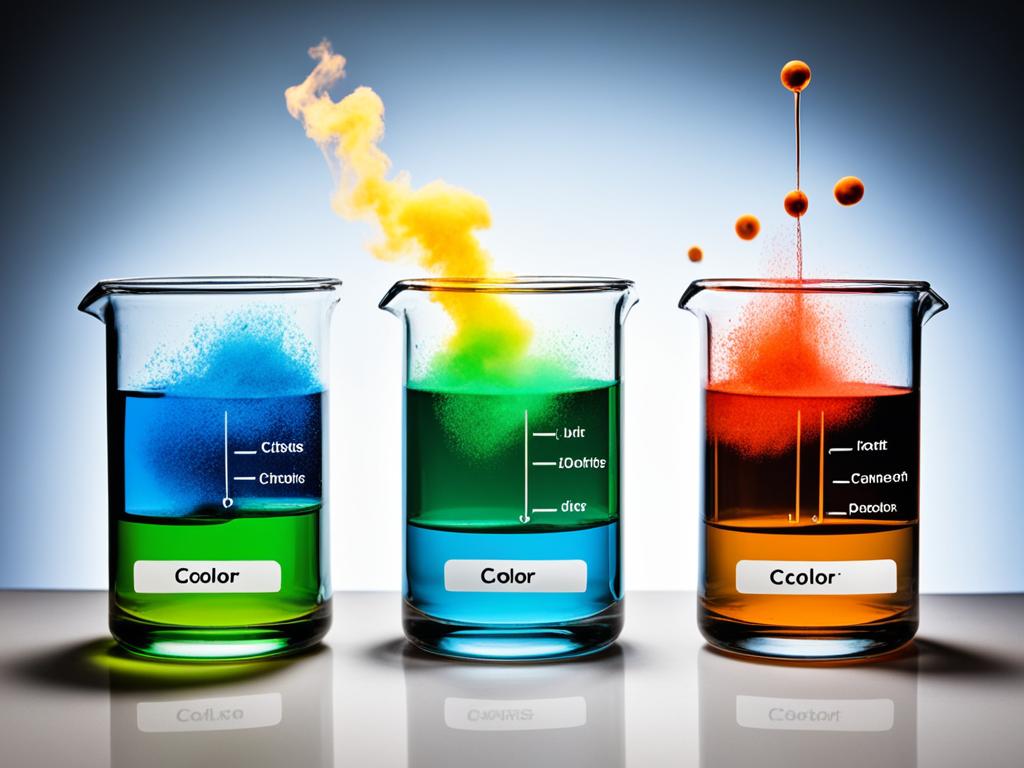Chemical reactions are key processes where substances change to form new ones. These changes depend on chemical bonds breaking and forming. They can lead to energy release, color shifts, or gas production.
Researchers have looked deeply into how these reactions work. Their findings help improve medicine, protect the environment, and much more.
Key Takeaways
- Chemical reactions involve the transformation of reactants into products.
- These transformations are marked by breaking and forming of chemical bonds.
- Observable changes during reactions may include energy release, color change, or gas production.
- Understanding reaction mechanisms is crucial for advancements in various industries.
- Research in chemical interactions has implications for pharmaceuticals and environmental science.
Introduction to Chemical Reactions
Chemical reactions transform reactants into products. This process examines reactants conversion and substance interactions. Various chemical reaction characteristics make each reaction unique. They affect reaction speed and energy changes.
Reactions play a key role in both nature and industry. They support life through processes like photosynthesis and respiration. In industries, they are crucial for making quality products. Engineers and scientists work to make these processes better and more eco-friendly.
Studying chemical reactions starts with understanding their types and mechanisms. Knowing about chemical reaction characteristics, like order and kinetics, is essential. It helps in fields such as pharmaceuticals to create new drugs.
Understanding Chemical Equations
Chemical equations are a simple way to show chemical reactions. They list reactants and products and how they relate. Using the right chemical equation is key for clear chemistry communication.
What are Chemical Equations?
A chemical equation shows a chemical reaction with symbols. It makes the reaction easy to understand. It shows how substances change into new compounds.
Balanced Chemical Equations: Importance and Methods
Balancing chemical equations follows the law of conservation of mass. This law says mass stays the same in reactions. You must make sure atoms count matches on both equation sides. There are ways like the inspection method to balance them.
Common Symbols and Notations in Chemical Equations
Chemical equations use symbols to share details about reactions. Coefficients tell us how many molecules or moles are there. States of matter show if substances are solid, liquid, gas, or aqueous. Knowing these helps understand the reaction’s stoichiometry and predict results.
| Symbol | Meaning |
|---|---|
| + | Separates two reactants or products |
| → | Indicates the direction of the reaction |
| (s) | Solid state |
| (l) | Liquid state |
| (g) | Gaseous state |
| (aq) | Aqueous solution |
Types of Chemical Reactions
Chemical reactions come in different types, depending on what is reacting and what’s formed. Knowing these types helps us predict what will happen in experiments and everyday reactions.

Synthesis Reactions: Combining Elements
Synthesis reactions, or combination reactions, make one complex product from two or more simple substances. For instance, combining hydrogen and oxygen to make water is a synthesis reaction. It’s how new compounds are formed.
Decomposition Reactions: Breaking Down Compounds
In decomposition reactions, a compound splits into simpler parts. A good example is heating calcium carbonate, which breaks into calcium oxide and carbon dioxide. It’s the opposite of a synthesis reaction.
Single Displacement Reactions
Single displacement reactions happen when an element replaces another in a compound. Like when zinc meets hydrochloric acid, and the zinc replaces the hydrogen, making zinc chloride. It shows the reactivity of metals.
Double Displacement Reactions
Double displacement reactions involve swapping ions between two compounds, creating new ones. When silver nitrate reacts with sodium chloride, silver chloride and sodium nitrate are made. It’s like a dance between ions.
Combustion Reactions: The Role of Oxygen
Combustion reactions burn substances in oxygen, releasing energy, heat, and light. It’s essential for powering things, like cars burning gasoline. This reaction shows how important oxygen is for generating energy.
Energy Changes in Chemical Reactions
Understanding energy changes is key in chemical reactions. These changes split into endothermic processes and exothermic processes. They play a big role, from keeping industries safe to making materials that save energy. The idea that energy can’t be made or destroyed, only moved or changed, is at the heart of this.
Endothermic processes soak up energy, often as heat. This causes the surroundings to cool down. On the flip side, exothermic processes let out energy. This makes the temperature go up. Knowing these patterns helps chemists guess how reactions will go. It also helps them make industries run better.
The idea of energy conservation tells us energy stays the same before and after a reaction. This is key for understanding how reactions happen spontaneously. It’s also vital for making technologies that save energy and are good for the planet. By using this knowledge, different areas can improve their methods. They aim to use less energy and work more effectively.
| Process Type | Energy Effect | Application Examples |
|---|---|---|
| Endothermic | Energy Absorbed | Photosynthesis, Melting Ice |
| Exothermic | Energy Released | Combustion, Respiration |
Endothermic Reactions: Absorbing Energy
Endothermic reactions absorb energy from around them. This makes the place cooler where they occur. The energy they take in helps the reaction to move forward. These reactions are interesting in science and real-world situations.
Characteristics of Endothermic Reactions
The key feature of endothermic reactions is heat absorption. Here, the energy to break bonds in the reactants is more than the energy from forming new bonds in the products. This leads to energy being taken in and a cooler reaction mixture. These reactions often show a positive enthalpy change. This means the products are higher in energy than the reactants.
Examples of Endothermic Reactions
Looking at examples helps us understand endothermic reactions better.
- Photosynthesis: A major example is photosynthesis in plants. Plants take in sunlight to change carbon dioxide and water into glucose and oxygen. This energy is crucial for plants and all life on earth.
- Ammonium Nitrate Dissolution: When ammonium nitrate dissolves in water, it pulls in heat. This causes the temperature to fall. This reaction is often used in cold packs for sports injuries.
These examples show how important the taken-in thermal energy is. It’s key for both natural processes like photosynthesis and practical ones like cold packs for injuries. Endothermic reactions play a big role in agriculture and medical care.
Exothermic Reactions: Releasing Energy
Exothermic reactions release energy as heat or light. This makes the area around it warmer. They are different from endothermic reactions that take in energy. We will look at what makes exothermic reactions special and some examples.
Characteristics of Exothermic Reactions
These reactions are known for giving off thermal energy. You can see this as a temperature rise or light. For instance, when fuels burn, chemical bonds break and form new ones, letting out a lot of heat. Exothermic reactions are marked by:
- Increase in temperature during the reaction
- Emission of light or flames
- Release of heat to the surroundings
Examples of Exothermic Reactions
Many daily and important industrial reactions are exothermic. A good example is burning substances with oxygen, like in engines. This concept is a key energy source and applies in many areas. Here are some examples:
- Combustion of fossil fuels: Powers plants and engines.
- Respiration in living organisms: Gives energy for cells.
- Thermite reaction: Produces heat for welding and cutting metal.

In summary, knowing how exothermic reactions release energy is vital. It helps us use these processes in fields ranging from industry to biology. This understanding leads to new uses, making it important in science.
Activation Energy: The Energy Needed to Start a Reaction
Activation energy is like a gatekeeper for a chemical reaction to happen. It’s the energy barrier that molecules must leap over. Think of it as needing enough energy to push a boulder up and over a hill.
We see this concept in daily life events, like lighting a match. The friction from striking a match supplies the needed heat for combustion. Enzymes, our body’s natural catalysts, lower this barrier for vital functions, boosting the reaction rate.
Catalysts are heroes in both nature and industry because they speed up reactions without being used up. They are key in making drugs and supporting our body’s own chemical reactions.
Thanks to catalysts, we can see efficient reactions. They help lower the energy barrier and even work at cooler temperatures. This saves energy.
“Without catalysts, many reactions would be prohibitively slow or require extreme conditions, making them impractical for everyday use.” — Dr. James Watson, Nobel Laureate
By studying how activation energy, catalysts, and reaction rate work together, we unlock new advancements. This knowledge spans across fields like industry and health.
Chemical Reactions: Types, Equations, and Energy Changes
Chemical reactions show how substances change and interact. We explore reaction kinetics to understand reaction speeds. It’s also important to know about equilibrium. This is when reactions balance out, keeping reactants and products steady.
Chemical reactions can be reversible. Reversible reactions don’t just finish. Instead, they keep a balance between reactants and products. This idea is key in making ammonia and in nature too.
Let’s look at different reaction types like synthesis and combustion. Writing out chemical equations helps us see how reactants turn into products. These equations tell us about the reaction’s stoichiometry and energy changes.
Reaction kinetics is about how things like temperature affect reaction speed. Chemists use this to speed up or slow down reactions. This is crucial for making products efficiently or for research.
Balancing reactions is part of understanding equilibrium. Knowing this helps predict how much product you’ll get. The concepts of reaction kinetics, equilibrium, and reversible reactions are fundamental. They impact many areas, from environmental science to medicine.
Heat of Reaction: Quantifying Energy Changes in Reactions
The heat of reaction is a key concept in thermodynamics. It shows the heat energy gained or lost in a chemical reaction. This change affects the temperature around the reaction.
Understanding Heat of Reaction
There are two main kinds of reactions: exothermic and endothermic. Exothermic reactions release heat, making things warmer. Endothermic reactions take in heat, making things cooler.
By knowing how heat moves in these reactions, scientists can figure out their energy needs and products. This knowledge is vital for studying thermodynamics.
Measuring Heat of Reaction
Scientists use calorimetry to measure reaction heat. A calorimeter is a tool that captures heat from chemical reactions. Through careful experiments, calorimetry offers precise data on how heat changes during reactions.
Enthalpy is a key term in thermodynamics. It measures a system’s total heat. Enthalpy helps calculate reaction heat by including both internal energy and the work done by the system. Understanding enthalpy changes helps researchers study the energy in chemical reactions more deeply.
Practical Applications of Chemical Reactions
Chemical reactions are key in many industries, making materials and drugs. Chemical engineers use these reactions to make solvents, polymers, and important medicines. This knowledge changes how products are made and makes manufacturing better and bigger. For example, making polyethylene for plastic bags and bottles requires precise chemical reactions.
Chemical reactions also affect the environment greatly. They are crucial for cleaning wastewater, controlling air pollution, and finding new energy sources. Scientists use these reactions for safer, cleaner environmental methods. For example, cars have catalytic converters. These use chemical reactions to clean the exhaust and reduce pollution.
In biochemistry, chemical reactions are basic to life and health. These reactions allow organisms to use nutrients and make DNA. Breakthroughs in biochemistry bring new treatments and tests, affecting medicine and health care. Understanding these complex reactions helps in genetics and drug development.


